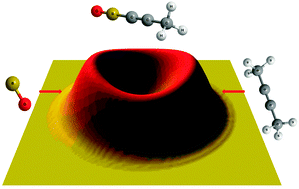A crossed molecular beam and ab initio investigation of the exclusive methyl loss pathway in the gas phase reaction of boron monoxide (BO; X2Σ+) with dimethylacetylene (CH3CCCH3; X1A1g)†
Abstract
The crossed molecular beam reaction of boron monoxide (11BO; X2Σ+) with dimethylacetylene (CH3CCCH3; X1A1g) was investigated at a collision energy of 23.9 ± 1.5 kJ mol−1. The scattering dynamics were suggested to be indirect (complex forming reaction) and were initiated by the addition of 11BO(X2Σ+) with the radical center located at the boron atom to the π electron density at the acetylenic carbon–carbon triple bond without entrance barrier leading to cis–trans11BOC4H6 doublet radical intermediates. cis-11BOC4H6 underwent cis–trans isomerization followed by unimolecular decomposition via a methyl group (CH3) loss forming 1-propynyl boron monoxide (CH3CC11BO) in an overall exoergic reaction (experimental: −91 ± 22 kJ mol−1; theoretical: −105 ± 9 kJ mol−1; NIST: −104 ± 12 kJ mol−1) via a tight exit transition state; trans-11BOC4H6 was found to lose a methyl group instantaneously. Neither atomic nor molecular hydrogen loss pathways were detectable. The experimental finding of an exclusive methyl loss pathway gains full support from our computational study predicting a methyl group versus atomic hydrogen loss branching ratio of 99.99% to 0.01% forming 1-propynyl boron monoxide (CH3CC11BO) and 1-methyl-propadienyl boron monoxide (CH3(11BO)CCCH2), respectively.


 Please wait while we load your content...
Please wait while we load your content...